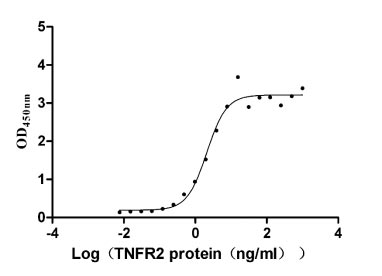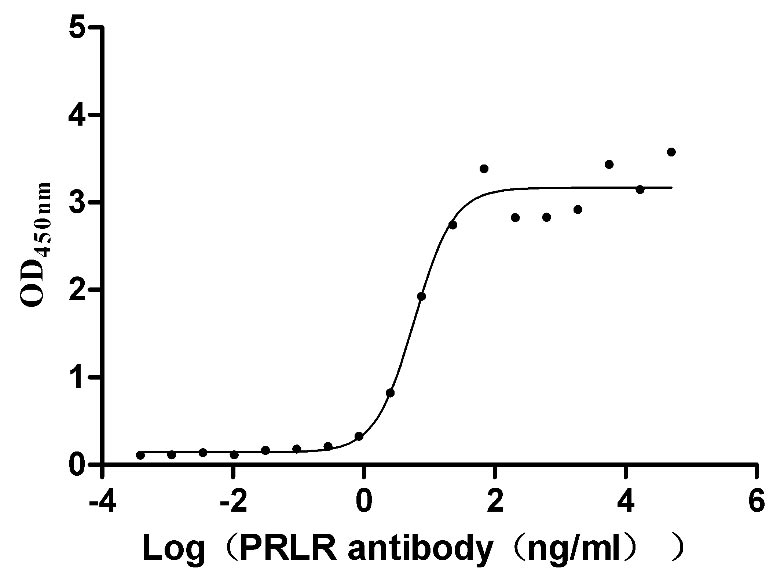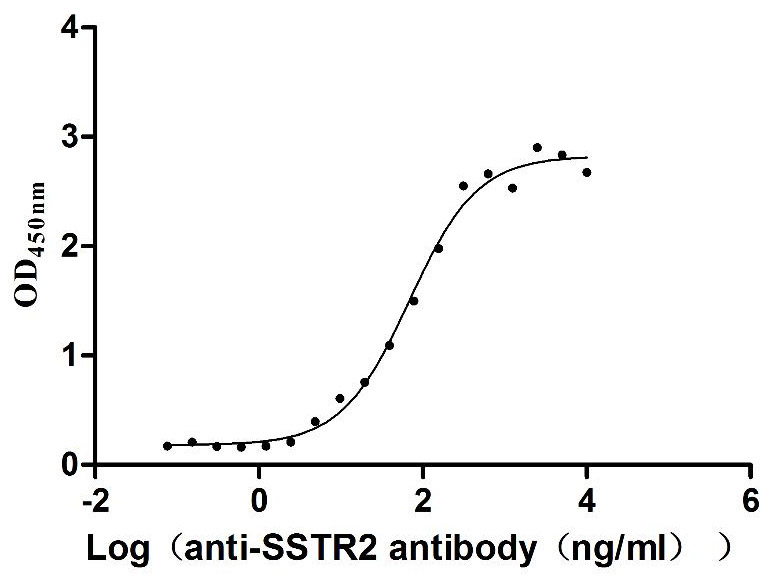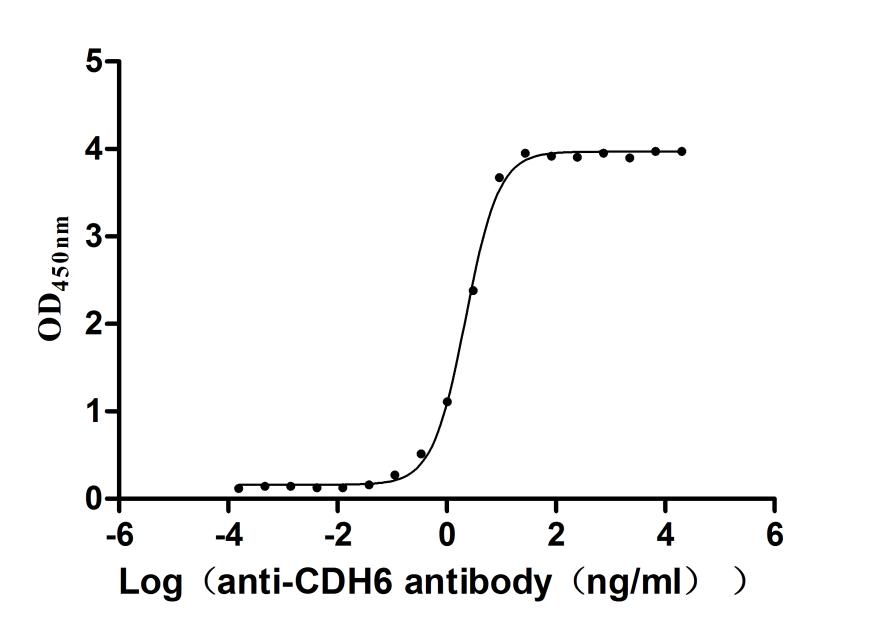Recombinant Mouse Neural cell adhesion molecule L1-like protein (Chl1), partial
-
中文名稱:Recombinant Mouse Neural cell adhesion molecule L1-like protein(Chl1) ,partial
-
貨號:CSB-YP005355MO
-
規(guī)格:
-
來源:Yeast
-
其他:
-
中文名稱:Recombinant Mouse Neural cell adhesion molecule L1-like protein(Chl1) ,partial
-
貨號:CSB-EP005355MO
-
規(guī)格:
-
來源:E.coli
-
其他:
-
中文名稱:Recombinant Mouse Neural cell adhesion molecule L1-like protein(Chl1) ,partial
-
貨號:CSB-EP005355MO-B
-
規(guī)格:
-
來源:E.coli
-
共軛:Avi-tag Biotinylated
E. coli biotin ligase (BirA) is highly specific in covalently attaching biotin to the 15 amino acid AviTag peptide. This recombinant protein was biotinylated in vivo by AviTag-BirA technology, which method is BriA catalyzes amide linkage between the biotin and the specific lysine of the AviTag.
-
其他:
-
中文名稱:Recombinant Mouse Neural cell adhesion molecule L1-like protein(Chl1) ,partial
-
貨號:CSB-BP005355MO
-
規(guī)格:
-
來源:Baculovirus
-
其他:
-
中文名稱:Recombinant Mouse Neural cell adhesion molecule L1-like protein(Chl1) ,partial
-
貨號:CSB-MP005355MO
-
規(guī)格:
-
來源:Mammalian cell
-
其他:
產(chǎn)品詳情
-
純度:>85% (SDS-PAGE)
-
基因名:Chl1
-
Uniprot No.:
-
別名:Chl1; Call; Neural cell adhesion molecule L1-like protein; Cell adhesion molecule with homology to L1CAM; Chl1-like protein; Close homolog of L1) [Cleaved into: Processed neural cell adhesion molecule L1-like protein]
-
種屬:Mus musculus (Mouse)
-
蛋白長度:Partial
-
蛋白標(biāo)簽:Tag?type?will?be?determined?during?the?manufacturing?process.
The tag type will be determined during production process. If you have specified tag type, please tell us and we will develop the specified tag preferentially. -
產(chǎn)品提供形式:Lyophilized powder
Note: We will preferentially ship the format that we have in stock, however, if you have any special requirement for the format, please remark your requirement when placing the order, we will prepare according to your demand. -
復(fù)溶:We recommend that this vial be briefly centrifuged prior to opening to bring the contents to the bottom. Please reconstitute protein in deionized sterile water to a concentration of 0.1-1.0 mg/mL.We recommend to add 5-50% of glycerol (final concentration) and aliquot for long-term storage at -20℃/-80℃. Our default final concentration of glycerol is 50%. Customers could use it as reference.
-
儲(chǔ)存條件:Store at -20°C/-80°C upon receipt, aliquoting is necessary for mutiple use. Avoid repeated freeze-thaw cycles.
-
保質(zhì)期:The shelf life is related to many factors, storage state, buffer ingredients, storage temperature and the stability of the protein itself.
Generally, the shelf life of liquid form is 6 months at -20°C/-80°C. The shelf life of lyophilized form is 12 months at -20°C/-80°C. -
貨期:Delivery time may differ from different purchasing way or location, please kindly consult your local distributors for specific delivery time.Note: All of our proteins are default shipped with normal blue ice packs, if you request to ship with dry ice, please communicate with us in advance and extra fees will be charged.
-
注意事項(xiàng):Repeated freezing and thawing is not recommended. Store working aliquots at 4°C for up to one week.
-
Datasheet :Please contact us to get it.
靶點(diǎn)詳情
-
功能:Extracellular matrix and cell adhesion protein that plays a role in nervous system development and in synaptic plasticity. Both soluble and membranous forms promote neurite outgrowth of cerebellar and hippocampal neurons and suppress neuronal cell death. Plays a role in neuronal positioning of pyramidal neurons as well as in regulation of both the number of interneurons and the efficacy of GABAergic synapses. May play a role in regulating cell migration in nerve regeneration and cortical development. Potentiates integrin-dependent cell migration towards extracellular matrix proteins. Recruits ANK3 to the plasma membrane.
-
基因功能參考文獻(xiàn):
- The correlation between the tumor size and the amount of CHL1 secretion could be examined in this study, and showed a significant positive correlation in a tumor size-dependent manner. PMID: 29775614
- investigated temporal discounting in CHL1-deficient (KO) mice and their wild-type littermates. Although no discounting differences were found under baseline conditions, CHL1-KO mice showed increased impulsive choice following chronic unpredictable stress (fewer % larger-later choices, and reduced area under the discounting curve). Impulsive choice alterations were reversed by the 5-HT2C agonist Ro 60-0175. PMID: 28583411
- The results of the present study indicate that CHL1 triggers PTCH1-, SMO-, RhoA- and ROCK-dependent signal transduction pathways to promote neuronal survival after cessation of the major morphogenetic events during mouse cerebellar development. PMID: 28630165
- These results provide strong support for a 'two-hit' (genes x environment) effect on latent inhibition in CHL1-deficient mice, and identify CHL1-deficient mice as a model of schizophrenia-like learning and attention impairments. PMID: 28647594
- Findings indicate that disrupted-in-schizophrenia 1 (DISC1) and close homolog of L1 may engage in physical and functional interaction in neural development, supporting the notion that DISC1 regulates neurite outgrowth with a receptor belonging to the neural cell adhesion molecules. PMID: 27346367
- results demonstrate that CHL1 regulates signal transduction pathways through constitutively active 5-HT2c receptor isoforms, thereby altering 5-HT2c receptor functions and implicating CHL1 as a new modulator of the serotonergic system. PMID: 26527397
- This study provided novel evidence for the functional importance of CHL1 in the post-natal maturation and maintenance of inhibitory circuits and synaptic plasticity in the mouse hippocampus. PMID: 26285062
- homophilic CHL1 transinteractions regulate early differentiation of NSCs. heterophilic transinteractions of CHL1 with vitronectin, integrins, and plasminogen activators regulate neuritogenesis and neural cell migration later in cerebellar morphogenesis. PMID: 25355214
- CHL1 is a novel intrinsic factor that is involved in carotid body function and in the ventilatory response to acute hypoxia. PMID: 23949217
- CHL1 endocytosis are required for CHL1-dependent neurite outgrowth. PMID: 23144456
- CHL1 might play an important role in hypoxia damage regulation. PMID: 22097715
- BACE1(-/-) axon guidance defects are likely the result of abrogated BACE1 processing of CHL1 and BACE1 deficiency produces a CHL1 loss-of-function phenotype PMID: 22988240
- L1 and CHL1 are cleaved by BACE1 under physiological conditions PMID: 22692213
- This study provided evidence that the CHL1 affect the repair of the blood-spinal cord barrier repair in soinal cord injury. PMID: 22473292
- Results describe the negative modulation of the proliferation and neuronal differentiation of neural progenitor cells by CHL1/ERK1/2 MAPK signaling. PMID: 20933598
- The results of this study implicated a novel mechanism in which L1 and CHL1 interact with individual EphA receptors and cooperate to guide subpopulations of thalamic axons to distinct neocortical areas essential for thalamocortical connectivity. PMID: 20576928
- a novel role for CHL1 PMID: 20711454
- Elevated CHL1 expression by reactive astrocytes requires activation of PI3K/PKCdelta-dependent pathways; reduction of PI3K/PKCdelta activity represents a therapeutic target to downregulate CHL1 expression, benefitting axonal regeneration after SCI. PMID: 19672967
- data show that the permanent absence of CHL1 results in misguided axonal projections and aberrant axonal connectivity and alters the exploratory behavior in novel environments, suggesting deficits in information processing in CHL1-deficient mice. PMID: 12391163
- a role of the protein in the lesioned central nervous system PMID: 12605410
- The CHL1-deficient mice displayed signs of decreased stress and a modification of exploratory behaviour. PMID: 14659567
- shedding of the CHL1 promotes neurite outgrowth and suppresses neuronal cell death PMID: 14761956
- The neural cell recognition molecule Close Homolog of L1 (CHL1) is required for neuronal positioning and dendritic growth of pyramidal neurons in the posterior region of the developing mouse neocortex. PMID: 15504324
- Prepulse inhibition of the acoustic startle response is impaired in mice deficient in CHL1. PMID: 15533325
- CHL1-Fc saved the same number of motoneurons as did L1-Fc PMID: 15880726
- Reduced reactivity to novelty, impaired social behavior, and enhanced basal synaptic excitatory activity in perforant path projections to the dentate gyrus in young adult mice deficient in the neural cell adhesion molecule PMID: 17126027
- CHL1 is a glial scar component that restricts posttraumatic axonal growth and remodeling of spinal circuits by homophilic binding mechanisms. PMID: 17611275
- Both CHL1 and NB-3 interact with protein tyrosine phosphatase alpha and regulate its activity in the developing caudal cortex. PMID: 18046458
- These results identify a novel function for CHL1 in thalamic axon responsiveness to ventral telencephalic cues, and demonstrate a role for CHL1 and Npn1 in establishment of proper targeting of specific thalamocortical projections. PMID: 18077678
- CHL1 a molecular signal in the organization of stellate axon arbors and in directing their dendritic innervation PMID: 18447583
- CHL1 affects axonal guidance and the anatomy of the ventricular system and the cerebellar vermis but act differently on these processes. PMID: 18588951
- a role for CHL1 in the adult-brain in the short-term maintenance of information. PMID: 19074023
- Data show that CHL1 promotes Purkinje and granule cell survival and granule cell migration during cerebellar development. PMID: 19226508
- did not observe differences in methylation of CpG islands in the promoter regions of NCAM, L1 and CHL1, nor in the promoter region of the glucocorticoid receptor in the hippocampus. PMID: 19262122
- The results indicated that Chl1(-/-) mice showed severe impairment of the capacity to react to both spatial and non-spatial novelty. Chl1(+/-) mice were severely restricted in their ability to detect spatial changes. PMID: 19303029
顯示更多
收起更多
-
亞細(xì)胞定位:Cell membrane; Single-pass type I membrane protein. Note=Soluble forms produced by cleavage/shedding also exist.; [Processed neural cell adhesion molecule L1-like protein]: Secreted, extracellular space, extracellular matrix.
-
蛋白家族:Immunoglobulin superfamily, L1/neurofascin/NgCAM family
-
組織特異性:Expressed in the brain, in the cerebellum and in the spinal cord. Detected in the retina and the optic nerve. Expressed in neurons and glial cells in the central nervous system and by Schwann cells in the peripheral nervous system.
-
數(shù)據(jù)庫鏈接:
Most popular with customers
-
Recombinant Human Lymphotoxin-alpha (LTA) (Active)
Express system: Mammalian cell
Species: Homo sapiens (Human)
-
Recombinant Mouse Prolactin receptor (Prlr), partial (Active)
Express system: Mammalian cell
Species: Mus musculus (Mouse)
-
Recombinant Human Somatostatin receptor type 2 (SSTR2)-VLPs (Active)
Express system: Mammalian cell
Species: Homo sapiens (Human)
-
Recombinant Human Epithelial discoidin domain-containing receptor 1 (DDR1), partial (Active)
Express system: Mammalian cell
Species: Homo sapiens (Human)
-
Recombinant Human Claudin-6 (CLDN6)-VLPs (Active)
Express system: Mammalian cell
Species: Homo sapiens (Human)
-
Recombinant Macaca fascicularis Cadherin 6(CDH6),partial (Active)
Express system: Mammalian cell
Species: Macaca fascicularis (Crab-eating macaque) (Cynomolgus monkey)
-
Recombinant Human Mucin-13(MUC13),partial (Active)
Express system: yeast
Species: Homo sapiens (Human)






-AC1.jpg)











